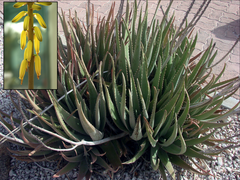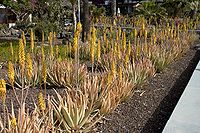Aloe vera
| Aloe vera subsp. var. | Aloe vera | |||||||||||||||||||||||||||||||||||||||||||||||||||||||
|---|---|---|---|---|---|---|---|---|---|---|---|---|---|---|---|---|---|---|---|---|---|---|---|---|---|---|---|---|---|---|---|---|---|---|---|---|---|---|---|---|---|---|---|---|---|---|---|---|---|---|---|---|---|---|---|---|

|
|
| ||||||||||||||||||||||||||||||||||||||||||||||||||||||
| ||||||||||||||||||||||||||||||||||||||||||||||||||||||||
Aloe vera, also known as the medicinal aloe, is a species of succulent plant that probably originated in Northern Africa, the Canary islands and Cape Verde. Aloe vera grows in arid climates and is widely distributed in Africa and other arid areas. The species is frequently cited as being used in herbal medicine.
Aloe vera is a stemless or very short-stemmed succulent plant growing to 60–100 cm (24–39 in) tall, spreading by offsets. The leaves are thick and fleshy, green to grey-green, with some varieties showing white flecks on the upper and lower stem surfaces.[1] The margin of the leaf is serrated and has small white teeth. The flowers are produced in summer on a spike up to 90 cm in tall, each flower pendulous, with a yellow tubular corolla 2–3 cm (0.8–1.2 in) long.[1][2] Like other Aloe species, Aloe vera forms arbuscular mycorrhiza, a symbiosis that allows the plant better access to mineral nutrients in soil.[3]
| Standard Cyclopedia of Horticulture |
|---|
|
Aloe vera, Linn. (A. perfoliala vera, Linn. A. elongata, Murr. A. barbadensis, Mill. A. vulgaris. Lam. A. flava, Pers.). Cespitose, the sts. at length 1-1.5 ft. high: lvs. suberect or spreading, gradually narrowed from the base, pale, 2-3 x 12-20 in., irregularly white-blotched and narrow when young and 2-ranked on offsets, the repand margin with weak pale prickles: infl. 2-3 ft. high, often simple; fls. 1 in. long, yellow, the segms. about equaling the oblong tube. Medit. region and intro. generally through the tropics. —The source of "Barbados aloes." Varies in a large Arabian form with broader lvs., taller infl., and fls. shading into orange, var. officinalis, Baker (A. officinalis, Forsk., A. rubescens, DC.); a smaller Asiatic form with red-tinged fls., var. chinensis (A. indica, Royle. A. chinensis, Baker); and a hardier garden form of this, var. Lanzae, Berger (A. Lanzae, Tod.). CH
|
Cultivation
Aloe vera has been widely grown as an ornamental plant. The species is popular with modern gardeners as a putatively medicinal plant and due to its interesting flowers, form and succulence. This succulence enables the species to survive in areas of low natural rainfall, making it ideal for rockeries and other low-water use gardens.[1] The species is hardy in zones 8–11, although it is intolerant of very heavy frost or snow.[2][4]
In pots, the species requires well-drained sandy potting soil and bright sunny conditions. The use of a good quality commercial propagation mix or pre-packaged "cacti and succulent mix" is recommended as they allow good drainage.[5] Terracotta pots are preferable as they are porous.[5] Potted plants should be allowed to completely dry prior to re-watering. During winter, A. vera may become dormant, during which little moisture is required. In areas that receive frost or snow the species is best kept indoors or in heated glasshouses.[2]
Propagation
- Do you have propagation info on this plant? Edit this section!
Pests and diseases
The species is relatively resistant to most insect pests, though mealy bugs, scale insects and aphid species may cause a decline in plant health.[6][7]
Species
Gallery
Aloe vera growing on a roadside in Aruba
References
- Standard Cyclopedia of Horticulture, by L. H. Bailey, MacMillan Co., 1963
External links
- w:Aloe vera. Some of the material on this page may be from Wikipedia, under the Creative Commons license.
- Aloe vera QR Code (Size 50, 100, 200, 500)
Cite error:
<ref> tags exist, but no <references/> tag was found








